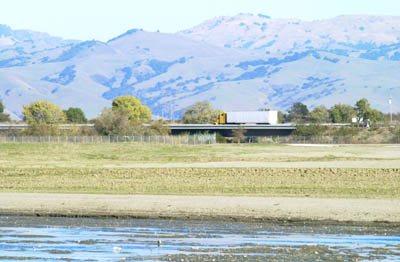
Like coaches in a rain-drenched football game, the city’s
wastewater leaders adjust for inclement times to prevent
disaster.
Like coaches in a rain-drenched football game, the city’s wastewater leaders adjust for inclement times to prevent disaster.
The foe this time around – a predicted El Nino winter – looks mightily imposing. The National Weather Service has predicted above normal precipitation through April for most of California, according to Derek Wroe, meteorologist with the NWS in Monterey.
And Hollister Councilman Brian Conroy has expressed concern about El Nino and its implications on the city’s wastewater operations.
“Are we taking every precaution?” Conroy said.
El Nino is a disturbance of the Pacific Ocean atmosphere causing increased rainfall and destructive flooding, according to the National Oceanic and Atmospheric Administration.
Winter rains always add an additional workload for wastewater officials as they monitor water levels and suppress potential floods and spills with a cautious eye. But this year, that added pressure may escalate even more – not only because of El Nino, but also because of Hollister’s surplus of sewage issues.
The city’s 15-million gallon sewage spill May 4 started a downpour of negative publicity and massive reform of Hollister’s wastewater management.
City officials must meet six project deadlines on its Long-term Wastewater Management Plan or pay fines up to $300,000 for each date missed. The Domestic Wastewater Seasonal Storage Pond is one of those projects. City Council awarded the contract to Mark Nicholson, Inc. Nov. 12.
Slower evaporation of disposal ponds during winter’s shorter days and potential river flooding can pose problems with pond capacities.
“You can end up with no place to put your water,” Public Works Director Clint Quilter said.
Quilter said one concerted effort by the city to add security during the rainy season is the seasonal storage pond.
Although the state’s Regional Water Quality Control Board required the pond, city officials had planned it anyway. Construction is scheduled to start in a “few days,” with completion scheduled for Jan. 1, Quilter said.
Once completed, the pond can hold an additional 30 million gallons of effluent. City Manager George Lewis said the pond would be a valuable asset during massive rainstorms.
Utility Manager Jim Perrine is accustomed to seasonal adjustments after 17 years with the city. He said wastewater strategies inherently change with the seasons.
“There are summertime operations, and there are wintertime operations,” Perrine said.
But if rainfall reaches extraordinary levels, Perrine said disaster is always possible. He is particularly worried about the San Benito River that flows adjacent to the percolation ponds. Protective levees separate the river from the treatment facilities, Perrine said, and a buffer area provides about 300 yards to 400 yards of security.
However, that distance can shrink rapidly. In the El Nino season of 1995, Perrine said the river crept up and caused concern.
“The river can meander and has meandered over history, Perrine said. “It could come back again this year.”
Perrine said they are “always monitoring water levels,” regardless of weather conditions.
In 1995, river overflow encroached toward the percolation beds, Perrine said, but plant workers reinforced levees to increase the distance between the river and percolation area.
The state of California suffered $1.95 billion in rainfall damage that season, the worst on record, according to the Golden Gate Weather Services.
“We were able to avoid any serious incidences by our diligence,” Perrine said.
Conroy remembered another El Nino year, 1998, when “the river went kind of wild.” He said awareness is essential because the city is treating more wastewater than ever before.
“I just want to make sure we’re anticipating, just in case,” Conroy said.
Officials plan to review wintertime treatment policies during the next month, Perrine said. And Quilter expressed confidence the city can defend against any potential disasters.
“We’re better off than we’ve been in the last several years,” Quilter said.








